2.1: Introduction to Poultry
- Page ID
- 21233
Sanitation is a key issue today due to the presence of salmonella bacteria associated with chicken. Therefore, be mindful of your food safety course principles learned in your first semester and adhere to good sanitation principles throughout class.
A well-organized satiation will keep you on track and aid in your organizational and sanitation skills. Below is an example of a properly organized station for chicken fabrication.
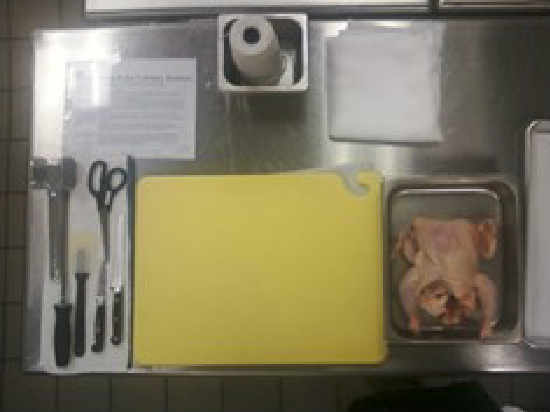
Photo courtesy of Marshall Welsh CEC
Clockwise from top left:
- Recipe - covered with plastic film for Sharpie® notes and protection
- Butcher twine in a 1/6 pan for sanitation and protection
- Cheese cloth - necessary if making galantine
- Half sheet pan with ½ sheet of parchment paper for fabricated parts and evaluation
- Chicken in a half pan over ice
- Sanitized yellow cutting board with wet towel under for safety
- Necessary tools on a folded towel. Note: Sanitizer stored below table is mandatory.
Often the first step in preparing poultry is to cut the bird in half. Broiler and fryer chickens are often split to make two portions. This procedure removes the backbone and breast bone (also known as the keel bone) for a neat finished product. The backbone, breastbone, and wing tips may be reserved for stock.
This is a favorite for Southern Barbecued Chicken and a brine will add a flavor and moisture that will separate you from the competition. When brining chicken, limit the time these chicken halves stay in the brine to 24 hours. After this, pat them to dry with paper towels and allow them
to form a pellicle in the cooler for several hours under refrigeration. At this point they are ready for grilling and smoking. Resist the temptation of brushing with your favorite barbecue sauce until late in the stages of cooking as the sauce contains sugar and can burn chicken in halves.
See in class demonstration on Chicken Fabrication.
Poultry Cuts - general information
Poultry refers to the edible flesh, with adhering bones, of any bird that is commonly used as food. Types of poultry include chickens, ducks, geese, turkey, quail, and pheasant. All poultry is processed in a similar manner. It is either cooked whole, or segmented in a number of ways depending on usage.
All segments of small, young poultry can be prepared using dry heat cooking methods. Older birds, once they stop laying eggs, are butchered and marketed as stewing hens, or boiling fowl. These birds need moist heat preparation and are ideal for pot pies, stews, and soups. All poultry should be fully cooked to at least 74°C (165°F) to eliminate the presence of salmonella.
| Game Hen | Young or immature progeny of Cornish chickens or of a Cornish chicken and a White Rock chicken ; very flavorful | 5-6 weeks | Split and broil or grill; roast | 2 lb. (1kg) or less |
|---|---|---|---|---|
| Broiler/fryer | Young with soft, smooth-textured skin; relatively lean; flexible breastbone | 13 weeks | Any cooking method; very versatile | 3 lb. 8 oz. (1.5 kg) or less |
| Roaster | Young with tender meat and smooth-textured skin; breastbone is less flexible than broiler's | 3-5 months | Any cooking method | 3 lb. 8oz.-5 lb. (1.5-2 kg) |
| Capon | Surgically castrated male; smooth-textured skin; bred for well-flavored meat; contains high proportion of light to dark meat and a relatively high fat content | Under 8 months | Roast | 6-10 lb. (2.5-4.5 kg) |
| Hen/stewing | Mature female; flavorful but less tender meat; nonflexible breastbone | Over 10 months | Stew or braise | 2 lb. 8 oz.-8 lb. (1-3.5 kg) |
A bird can be split in half lengthwise through the backbones and keel bone, or it can be split into a front quarter and a hindquarter. The front quarter of the bird contains the breast and wing meats, while the hindquarter contains the legs. It is common to continue to break the poultry into segments.
For maximum yield and precise processing, poultry can be segmented by cutting through the soft natural joints of the bird. The term 8-cut chicken is used to describe a chicken segmented into two drumsticks, two thighs, and both breasts split in half across the rib bone (one half may contain the wing). This procedure is always done with the bone in. These segments can be processed further to boneless skinless cuts if desired. Figure 29 shows a fully segmented frying chicken.
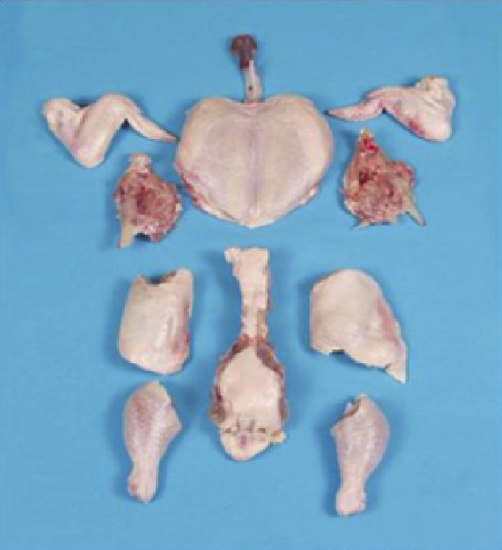
Figure 29. Segmented frying chicken. Photo by TRU Meat cutting department shared under CC-BY-NC 4
White Meat Cuts
White or light meat comes from the breast and wings. The breast and wings are generally separated, but a chicken breast with the drumette portion of the wing still attached is called a supreme. Wings can be broken down into three parts: wing tip, winglet, and wing drumett
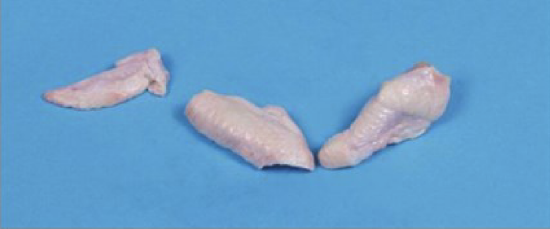
Figure 30. Segmented chicken wing. Photo by Jakes and Associated shared under CC-BY-NC 4.0
The breast can also be broken down further and the tenderloins (fillets) removed. The portion without the tenderloin can be split and pounded into a thin cutlet known as a pillards. Figure 31 shows the chicken breast whole and with the fillets removed from the bottom portion
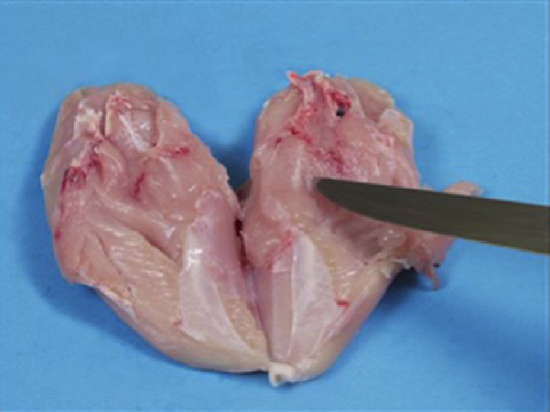
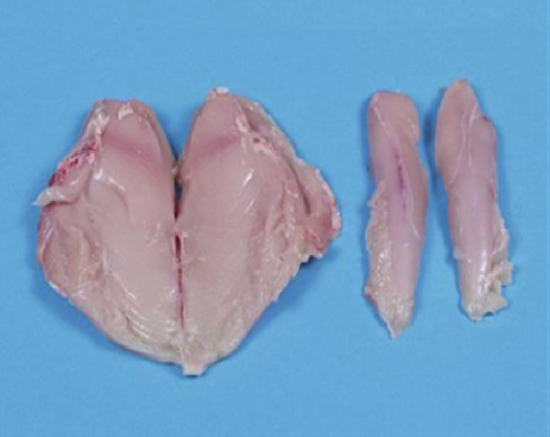
Figure 31 Boneless skinless chicken breast with fillets removed.
Photo by Jakes and Associates shared under CC- BY-NC 4.0
Dark Meat Cuts
The dark meat poultry comes from the legs, which can be broken down into two parts: the thigh and the drumstick. In restaurants, you may occasionally find a boneless leg that has been stuffed, which is called a Ballotine.
Chicken legs are split at the knee joint to separate the thigh from the drumstick. Drumsticks are usually cooked bone in, while thighs can be deboned and skinned to use in a variety of dishes, including slicing or dicing for stir-fry and similar dishes.
Figure 32 shows a whole chicken leg broken down into a drumstick and boneless thigh
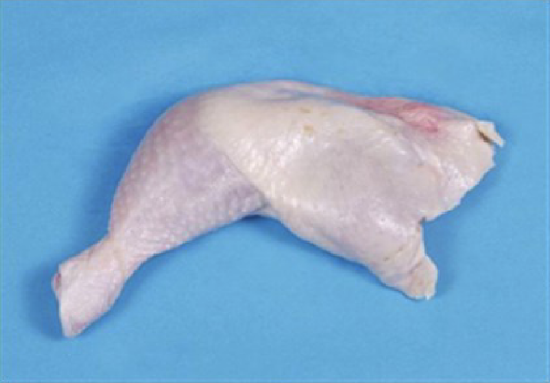
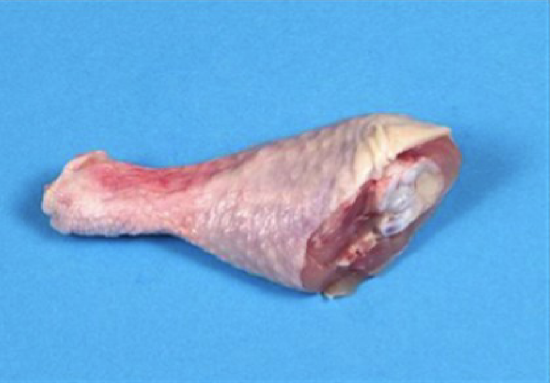
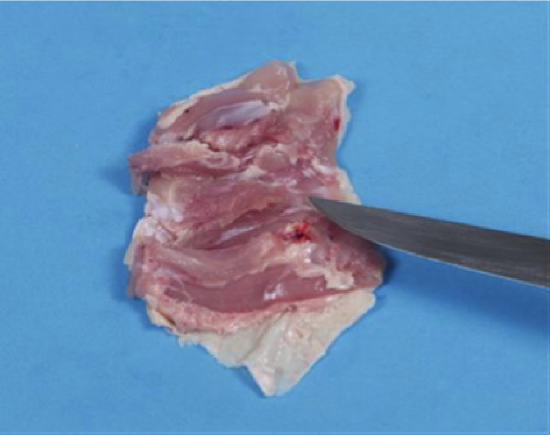
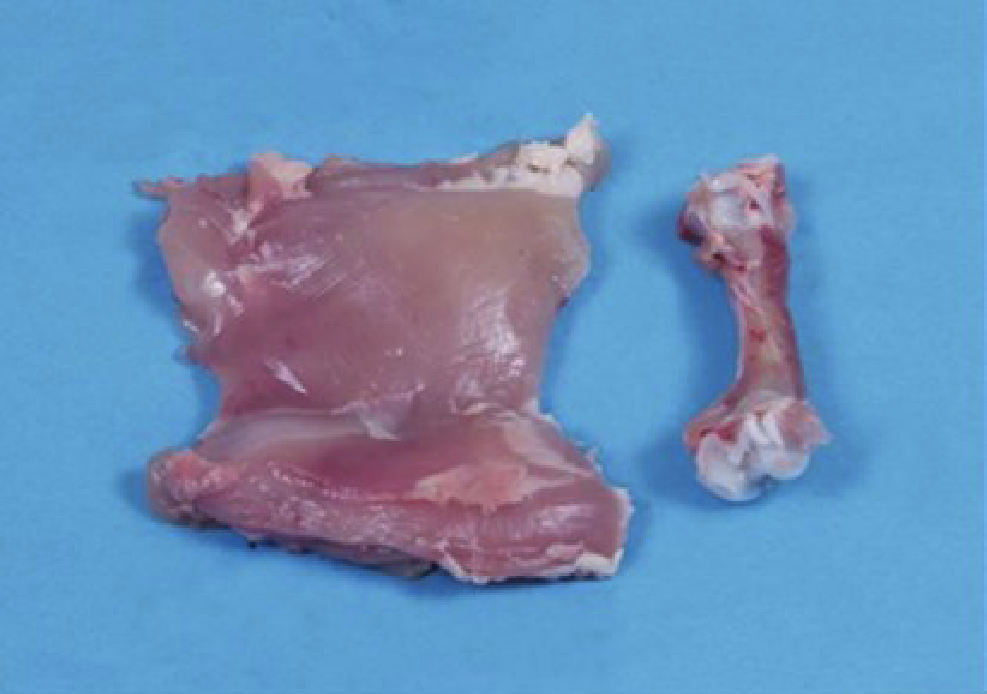
Figure 32 Breakdown of chicken leg.
Photo by Jakes and Associates shared under CC-BY-NC
POULTRY
Poultry is the collective term for domesticated birds bred for eating. They include chickens, ducks, geese, guineas, pigeons and turkeys. Poultry is generally the least expensive and most versatile of all main-dish foods. Almost any cooking method is applicable, and its mild flavor goes well with a wide variety of sauces and accompaniments.
Poultry also includes other birds killed for their meat, such as the young of pigeons (known as squabs) but does not include similar wild birds hunted for sport or food and known as game. The word "poultry" comes from the French/Norman word poule, itself derived from the Latin word pullus, which means small animal.
The domestication of poultry took place several thousand years ago. This may have originally been a result of people hatching and rearing young birds from eggs collected from the wild, but later involved keeping the birds permanently in captivity. Domesticated chickens may have been used for cockfighting at first and quail kept for their songs, but soon it was realized how useful it was having a captive-bred source of food.
Selective breeding for fast growth, egg-laying ability, conformation, plumage and docility took place over the centuries, and modern breeds often look very different from their wild ancestors. Although some birds are still kept in small flocks in extensive systems, most birds available in the market today are reared in intensive commercial enterprises.
Together with pig meat, poultry is one of the two most widely eaten types of meat globally, with over 70% of the meat supply in 2012 between them; poultry provides nutritionally beneficial food containing high-quality protein accompanied by a low proportion of fat. All poultry meat should be properly handled and sufficiently cooked in order to reduce the risk of food poisoning.
In this section, we discuss the different kinds and classes of poultry, and how to choose those that best suit your needs. You will learn how to store poultry properly to prevent food-borne illnesses and spoilage, how to butcher birds to produce the specific cuts you need, and how to apply a variety of cooking methods properly.
Many of the cooking methods discussed here apply to previously to meats. Although there are similarities with these methods, there are also many distinct differences.
MUSCLE COMPOSITION
The muscle tissue of poultry is similar to that of mammals in that it contains approximately 72 percent water, 20 percent protein, 7 percent fat and 1 percent minerals; it consists of bundles of muscle cells or fibers held together by connective tissue. Unlike red meat, poultry does not contain the intramuscular fat know n as marbling. Instead, a bird stores fat in its skin, its abdominal cavity and the fat pad near its tail. Poultry fat is softer and has a lower melting point than other animal fats. It renders easily during cooking.
As with red meats, poultry muscles that are used more often tend to be tougher than those used less frequently are. In addition, the muscles of an older bird tend to be tougher versus those of a younger one. Because the majority of poultry reaches the market at a young age, it is generally very tender.
The breast and wing flesh of chickens and turkeys is lighter in color than the flesh of their thighs and legs. This color difference is due to a higher concentration of the protein myoglobin in the thigh and leg muscles. Myoglobin is the protein that stores oxygen for the muscle tissues to use. Mo reactive muscles require more myoglobin and tend to be dark e r than Jess -active ones. Because chickens and turkeys generally do not fly, their breast and wing muscles contain little myoglobin and are therefore a light color. Birds that do fly have only dark meat. Dark meat also contains more fat and connective tissue than light meat, and its cooking time is longer.
Skin color may vary from white to golden yellow, depending on what feed the bird consumed. Such color differences are not an indication of overall quality.


